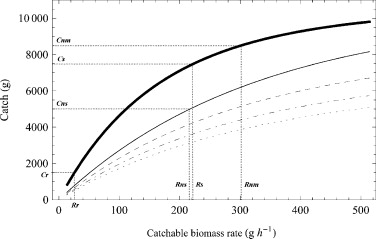 We developed a new approach for evaluating gillnet catches. A model of a gillnet catch was built to differentiate the effects of gillnet saturation, fish activity and fish escapement from the gillnet catch. The corrected gillnet catch, termed the catchable biomass rate in the text, is the weight of fish that can be caught within an hour by an empty gillnet during a period of unitary fish activity. We also observed the effects of soak time (2, 5, 8, 11 and 13 h) and sampling period (August vs. September) on the catch. Our results show that saturation and fish escapement from gillnets are important events occurring during each use, thus violating the assumption of a linear relationship between gillnet catch and fish density. The maximal capacity of a standardized benthic gillnet (45 m2 area, 12 mesh sizes that range from 5 to 55 mm) was assessed to be 11 kg, i.e., 245 kg 1000 m−2 of gillnet. Sampling time had only a negligible effect on the gillnet catch. We recommend using the catchable biomass rate instead of uncorrected gillnet catches in interpretation of obtained data, especially when the catches are above 3 kg per standardized gillnet (i.e., 67 kg 1000 m−2). We created a conversion table and a slide rule, from which the catchable biomass rates can be determined. We also developed a method for the conversion of catches based on different soak times. Our findings help to better understand the processes underlying gillnet catches and improve the interpretability and reliability of this method in comparing different gears used and assessing fish communities in general.
We developed a new approach for evaluating gillnet catches. A model of a gillnet catch was built to differentiate the effects of gillnet saturation, fish activity and fish escapement from the gillnet catch. The corrected gillnet catch, termed the catchable biomass rate in the text, is the weight of fish that can be caught within an hour by an empty gillnet during a period of unitary fish activity. We also observed the effects of soak time (2, 5, 8, 11 and 13 h) and sampling period (August vs. September) on the catch. Our results show that saturation and fish escapement from gillnets are important events occurring during each use, thus violating the assumption of a linear relationship between gillnet catch and fish density. The maximal capacity of a standardized benthic gillnet (45 m2 area, 12 mesh sizes that range from 5 to 55 mm) was assessed to be 11 kg, i.e., 245 kg 1000 m−2 of gillnet. Sampling time had only a negligible effect on the gillnet catch. We recommend using the catchable biomass rate instead of uncorrected gillnet catches in interpretation of obtained data, especially when the catches are above 3 kg per standardized gillnet (i.e., 67 kg 1000 m−2). We created a conversion table and a slide rule, from which the catchable biomass rates can be determined. We also developed a method for the conversion of catches based on different soak times. Our findings help to better understand the processes underlying gillnet catches and improve the interpretability and reliability of this method in comparing different gears used and assessing fish communities in general.
Keywords: catch correction; catch interpretation; CPUE; reservoir; video recording
